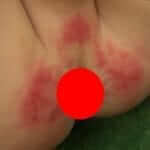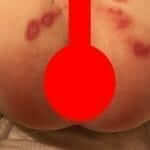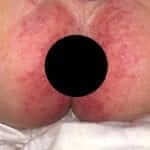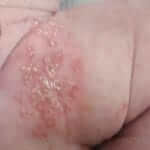
Diaper rash or diaper dermatitis?
In fact, these terms (diaper rash or diaper dermatitis) can refer to any rash that appears in the area of the diaper, but I do wish to focus on the typical rash, as you will see in the following photos, that appears in this area in babies.
What is diaper rash?
This skin inflammation (dermatitis) is very common during the first year of life. While some babies almost don’t suffer at all from this specific rash, other suffer more frequently. In addition, some babies have a mild rash that responds to standard interventions while others have a more persistent rash that responds slower to appropriate treatment treatments.
Why does rash develop in this area in particular?
A combination of local moisture with increased acidity, together with enzymes found in urine and stool that cause irritation and local inflammation. In addition, skin injury and cuts due to frequent handing of the area with cleaning and wiping. Later on, a secondary infection by fungus or bacteria that normally reside in that area and are only “waiting’ for the skin to be injured (it normally serves as a barrier between them and other deeper tissues) to thrive.
The odds to develop diaper rash are higher with more frequent bowel movements, for example during an illness that involves diarrhea. But sometimes the rash appears without a clear provocation.
What is the appearance of typical diaper rash?
The appearance is that of a red and irritated skin (first photo), in different areas or confluent, and up to an irritated and injured skin including bleeding and ulceration (second picture). A secondary infection by a bacteria or a fungus (Candida) will lead to a typical appearance in this area (third picture – the beginning of secondary infection, fourth picture- infection with candida in the thigh area).
The baby may be irritable when handling and wiping the area and diaper changing.

How is diaper rash treated?
In all cases it’s recommended to avoid contact of excretions (urine and stool) with the irritated skin. This can be done mainly by frequent diaper changes. I hear about cases when the child doesn’t suffer from a rash at home, but it appears when returning from kindergarten, mainly due to high workload and not changing diapers on time.
Brave parents may allow the baby to be diaper-less for short periods of time.
Cleaning of the area during diaper change is better done with light dabbing (no rough rubbing of the already injured skin) using a soft cloth and tepid water. Don’t use of wipes containing alcohol or perfuming.
The bottom may be washed with tepid water and soap (as gentle as possible). After washing, the skin should be dried well (gently, dabbing the skin and not rubbing).
Should we use a baby paste?
In every case and in every diaper change a paste should be applied, usually containing zinc, that will create a barrier between the excretions and the skin and protect it. There are so many types of pastes and creams for this purpose, my opinion is a simple paste containing zinc will do the job and there’s no need to be tempted to buy the expensive and branded pastes.
In the more persistent cases, it’s possible to treat with local creams that often contain local mild steroid, an antifungal treatment for Candida and local antibiotic.
The choice of a local therapeutic cream should be made in consultation with a pediatrician after a physical examination. There are many options (although usually, at the end of the day most creams for this indication are similar) and in theory, a specific treatment should be tailored for every case. A cream containing a mild potent steroid, that still do the job, should be chosen and applied for 3-5 days. Any longer treatments should be approved by the doctor and are usually not recommended.
In most cases, rapid improvement can be seen with the appropriate treatment but the rash may return in the future. All treatments mentioned above may be repeated.

A trick I use in persistent cases is applying a therapeutic cream (usually containing s steroid and antifungal) and on top of it I ask the parents to plaster with a payer of regular diaper paste. The therapeutic cream will treat the skin, and the external layer will hopefully prevent the excretions from reaching the skin.
In some intractable rare cases, one must refer to a pediatrician for reassessment. There are different diseases (rare, rare, rare) that may present with a rash in this area.
Good luck!

For comments and questions, please register
